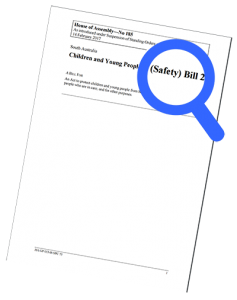 6 March 2017
6 March 2017
The Government introduced the Children and Young People (Safety) Bill 2017 into Parliament on 14 February. It’s purpose is to update the Children’s Protection Act 1993, add some elements from the Family and Community Services Act 1972, and enable a number of new initiatives that respond to Nyland Royal Commission recommendations.
Below we look at issues that directly bear on the Guardian’s mandate to promote the wellbeing of children and young people in state care. Organisations with other interests will, and have, addressed other aspects of the Bill.
Positive changes since the 2016 draft include:
- the inclusion of Chapter 8 – Providing safe environments for children and young people (see part 3.2 of the January GCYP submission)
- further strengthening of the SACAT clauses including s149 – Views of the child or young person to be heard
- some strengthening of the Aboriginal and Torres Strait Islander Child Placement Principle through reinsertion of engagement and consultation with the gazetted Aboriginal organisation.
- addition of “neglect” in the definition of harm (s14).
Issues with the 2017 Bill include:
- Section 29(7) allows the Chief Executive of the Department for Child Protection to “give directions or guidance in relation to a matter to a State authority to which the matter is referred” effectively undermining the independence of the Guardian.
- The replacement of the Minister as ‘main responsible person’ with the Chief Executive comes without any explanation or obvious rationale.
- The recognition of the importance of the voice of children is still insufficient. The “need to be heard and have their views considered” (s8(1)(a)) should be taken from that sub-clause location and given equivalent emphasis to that granted to safety in s7.
- The Aboriginal and Torres Strait Islander Child Placement Principle should be strengthened.
- The five interrelated domains: prevention, partnership, placement, participation and connection should be incorporated into the Bill.
- The obligation of the Department to “consult with, and have regard to any submissions of, a recognised Aboriginal or Torres Strait Islander organisation” should not be weakened by the s11(3)(c) rider, “where reasonably practical”.
- Section 11(5) acknowledges the capacity of an Aboriginal or Torres Strait Islander child or young person to make an informed decision not to identify as such but the legislation should safeguard the Department’s obligation to revisit the matter sensitively from time to time in order to stimulate and respond to a child or young person’s developing views and options.
- Section 68 introduces a clause to allow temporary placement of a child or young person when an approved carer is not available although Commissioner Nyland expressed concern about such temporary placements.
- s100(4) weakens the power of a child to complain about residential care by giving the Chief Executive the power to dismiss complaints they deem to be “frivolous or vexatious or not made in good faith” without defining these grounds more explicitly.
- s101(1) provides that the Chief Executive must, “at the request of a child or young person” leaving care, prepare a plan setting out steps to assist them in making their transition from care. The Department should be obliged to provide such a plan as a fundamental right.
- s144 should make it explicit that Internal Review extends to failure of the Chief Executive or a child protection officer to give effect to the entitlements of children and young people under this Act . It should provide an appeal mechanism and to guarantee access by the child to independent advocacy during the appeal process.
- s107(1) The Child and Young Person’s Visitor Scheme is still expressed as a discretionary matter for the Minister while it should be embedded in the legislation.
For more detail see Comments on the Children and Young People (Safety) Bill 2017 and
the earlier Guardian’s response to the draft Children and Young People (Safety) Bill 2016

